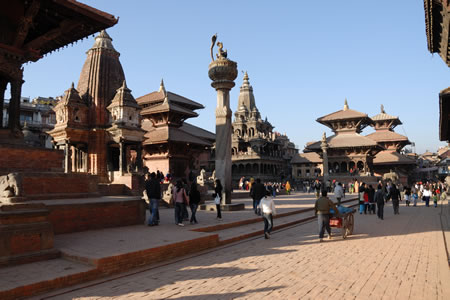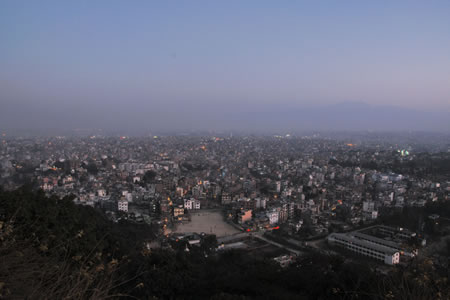English | Dutch |
|
| Myanmar? | |
Nagthali (Nepal) to Kathmandu (Nepal), Dec-27-07 / Jan-08-08 |
|
On Boxing Day, we were still in the Himalayas. Afterwards we had some more days to enjoy the beautiful views and the fresh and clean air. The changeover can’t be bigger when we drive back in eight hours to Kathmandu. When we approach the capital city of Nepal, we see already the thick layer of brownish/yellow fog that floats over the city. It is not odd that many people in Kathmandu cover their nose and mouth to prevent inhaling the polluted air. It seems that 12% of the premature deaths in Kathmandu are related to the bad quality of the air in the city. We only stay a week in Kathmandu, so for us the only ‘damage’ caused by the bad air is a sore throat and irritated eyes. These minor inconveniences are however compensated by the beautiful highlights that Kathmandu has to offer.
Kathmandu has a lot to offer to its visitors. It has beautiful buildings and other monuments. The nice thing about these monuments is that there are still part of daily city life. The temples are still intensively used for praying, but also for playing a game of chess. The former kingdom of Patan is also beautiful, with its immense density of temples. Everything can be seen on foot, giving you the feeling that you walk through an open air museum. It is great to stroll through the small alleys and courtyards and see how city life works. Children are playing cricket on the street, men are slaughtering animals, and women are washing the clothes and drying them on the fences around the temples. Also Pashupatinath, near Kathmandu, is worth a visit. This temple complex along the, for Hindus holy Bagmati river, is a place where you can observe open air cremations (see also the article about Pashupatinath). |
|
 |
|
The beautiful temples of Patan's Durbar Square |
|
| Our stay in Kathmandu is also for another reason very exciting. We applied for a Burmese (Myanmar) visa in the hope that we can visit the country again, after our previous visit in 2002. We thought that our chances were minimal, because of the unrest in Myanmar last six month. The Burmese people are repressed since 1962 by the military junta that rules the country already for decades with an iron fist. Once in a while the people of Myanmar try to realise a political change by demonstrating peacefully. This also happened last 6 months, mainly by the many monks of the country. However, the junta does not accept any call for change and quelled the demonstration with the use of the army. Some people died during the clashes with the army, and many were wounded and arrested. For several months, the situation in Myanmar was breaking news. But after the junta had ‘restored’ the rest, the situation in Myanmar is removed from the front pages of the newspapers. We applied for a visa at the Embassy of Myanmar in Kathmandu and without any fuss we got our visa two days later. Of course, after signing a paper that we understand that the situation in Myanmar is a domestic issue and that we will not be politically active while being in Myanmar.
There is a lot of discussion going on among travellers about the question to go to Myanmar, or not to go, because of the political situation. Roughly speaking, there are two movements in this discussion. The first movement, the pro-boycott group, believes that Myanmar must be boycotted as much a possible. This means that no tourist must go there and that companies must not trade with Myanmar. This group states that everybody who interacts with the country legitimises the military regime. Another argument they use is that some of the tourist infrastructure (like airfields, roads, hotels, etc) is made with the use of forced labour. A third important reason not to go is that the money tourists spend in Myanmar partly flows to the military regime. This money is afterwards used to repress the people. Or in other words, if you spend money in Myanmar, you finance the repression of the Burmese people. But like in most discussions, there is also a second movement. This movement, the anti boycott group, believes that travellers still should visit Myanmar. Also this group has some arguments. One of their main arguments is that the vast majority of the Burmese people still want foreigners to come to their country. They believe that a further isolation of the country will not help the process of a political change. More strongly, boycotts of Iraq, Iran, North Korea and Cuba proved that a boycott is not an effective weapon to force a political change in a country. This is also the signal that we got from the Burmese people when we visited the country back in 2002. A second argument of the anti boycott movement is that of every Euro or Dollar that travellers spend, more than 80% flows to the private sector, to the people that really need the money. A third important argument is that the presence of tourists will prevent that the people of the areas where tourists come, will not be brutally repressed. This is of course only true for the areas where travellers are allowed to come. | |
 |
|
The night falls over Kathmandu |
|
We finally decided to go. The main reason is that we know that the people of Myanmar really want travellers to visit their country. They do not want to become the “forgotten” people of the world. Besides that, they do not believe that a boycott will speed up the process of democracy. We also heard in previous journeys from people that live or lived under a boycott, like the people of Iran and Libya, that they do not understand a boycott. The only victims of the boycott are the normal people of the country. A boycott sometimes even works contra productive, like in Iran. The boycott is used by the repressive government to ‘show’ the people how bad the western world is. In this way they try to create a common enemy. Besides that, it is very hypocrite of the western world to boycott a country like Myanmar, and not countries with equal repressive governments like Tibet, Cuba, Vietnam and especially China. Another reason why this boycott is not going to work is that only the EU and the US are supporting the boycott. Other huge nations, like China, India and Japan, are still trading with Myanmar. Especially China has a huge economical influence in Myanmar. It is guessed that China controls more than 60% of the Burmese economy. Now that we have the visa for Myanmar, we used a couple of days to do some planning for the coming months. The visa for Myanmar is only valid for 28 days, and the only possibility to enter the country is by air (all land borders with the neighbouring countries are closed). Before we travel to Myanmar, we first want to see the North Eastern part of India and of course Bangladesh. Unfortunately, Biman, the international airline of Bangladesh, suspended its direct flights from Dhaka to Yangon (capital city of Myanmar). Besides that, Biman is a class two airlines, which means that they do not comply with all the security requirements demanded by the international aviation organisation. So, even if Biman would fly to Yangon, we probably preferred another airline. After spending some hours on the Internet, we booked a one way flight with GMG airlines from Dhaka to Bangkok, for March. This means that we have three to four weeks to spend in North Eastern India and six weeks in Bangladesh. We will spend a week in Bangkok, before we fly with Asia Air (budget airline in Asia) to Yangon. After our return from Myanmar we will spend another week in Bangkok before we take a one way trip to Kuala Lumpur in Malaysia. We already booked the flight to Kuala Lumpur because with the proof of an onward ticket, we are exempted from a Thai visa (max. 30 days stay in Thailand). The price for the Thai visa is approximately the same as the price of the ticket, so we have chosen for the ticket. Besides that, we already decided months ago that we will save our trip to Thailand for further down our journey. We left Kathmandu after all the puzzling was done and after we booked all the flights. It is now time for our last big highlight in Nepal: Chitwan National Park.
|
|
| <Previous weblog> | |